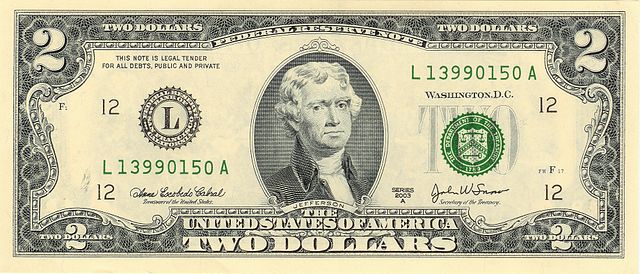Thomas Jefferson’s Silent Armies

Thomas Jefferson was the primary author of the Declaration of Independence, the first Secretary of State of the United States, its third President, and in general, a central figure in America’s early days as a republic. He’s depicted on Mount Rushmore along with George Washington, Abraham Lincoln, and Theodore Roosevelt. If you live in the United States, you probably have a few images of him lying around; just check your pockets. He’s on the nickel. He’s also on the $2 bill, but it’s unlikely you have one of those at the ready, because they’re not all that common. While $2 bills are still in circulation, less than 1% of the bills produced each year are of that denomination. Retail cash registers don’t typically have slots for them, and if you get one as change, that’d be surprising, to say the least. In many cases, banks do not even have them. Two dollar bills certainly exist — but you wouldn’t know it.
Which makes them an effective protest tool.
Throughout history, there are many examples of relatively small groups of people feeling neglected or taken for granted. In many cases, the impact of that smaller group on the local economy is significant, but hard to quantify, and even harder to see. To fix this, maybe grab a large pile of Jeffersons?
The idea is simple. First, gather a group of people who each support an issue. Then, have them patronize local businesses, paying only in cash, and wherever possible, using $2 bills. Eventually, the stores will have to give the recently-received $2 bills to other customers as change, and as the bills spread, so will the bemused puzzlement of the townsfolk: where did all these $2 bills come from? Finally, you take to the local paper to explain, demonstrating your group’s impact on the local economy.
This is by no means an original idea, though. Hardly. This tactic has been used for decades and by many very different groups. One of the earliest examples is cited by a newspaper article from 1964, notable because the $2 bill would be discontinued just two years later (and reintroduced for the U.S. bicentennial in 1976). In that example, military bases threatened with closure would advise soldiers stationed there to use $2 bills within the local area. Unfortunately, the scheme then often failed because bills of that denomination were often considered a bad omen (really) and downstream recipients would either refuse them or otherwise make them disappear.
In 1977 — just a year after the currency’s reintroduction – the $2 bill tactic was used by football enthusiasts. Georgia Tech, in Atlanta, and Clemson University, South Carolina were football rivals, playing at each other’s stadium in alternating years. But for some reason, Georgia Tech refused to travel north, and in response, Clemson announced that the 1977 game in Atlanta would be the final one between the schools. A Clemson booster encouraged fans traveling to that game to spend $2 bills to show the revenue that the area would lose out on. While the story made the press, it’s hard to say if it worked — the rivalry resumed in 1983, but there were other factors at play.
Nevertheless, many others have tried the same type of economic-signaling marketing campaign. Other examples range from the strange — participants at a barbershop quartet convention, skydivers, and nudists have all employed the tactic — and more serious, politically–charged ones. In any event, the next time someone hands you back your change with a $2 bill in it, there may be a reason why.
Bonus fact: If you get a lot of $2 bills, don’t spend them all at once. No, that’s not “save your money” advice. It’s “your merchant may think you’re doing something illegal” advice. In 2005, a Maryland-area man named Mike Bolesta ordered a new car stereo for his son from Best Buy, and, due to a mix-up, the store waived the installation charges — at first. As the Baltimore Sun explained, Best Buy (per Bolesta) withdrew that offer and demanded $114 for installation. So Bolesta — who gave away $2 bills as part of his tour guide business — reached into his stash of uncommon currency. When he tried to pay Best Buy with 57 $2 bills, they assumed the bills were fake and called the police. Bolesta was taken to the county jail, shackled, and the Secret Service was called in before he was released.
From the Archives: Hawaii Dollars: The story of another very rare piece of American currency.
Related: Three $2 bills for $12.99. They’re in “pristine” condition per the positive comments, but it seems like a pretty bad deal if you intend to spend them (especially at Best Buy).
